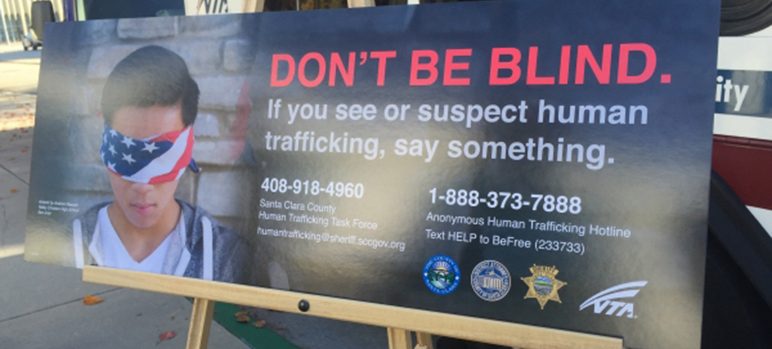It took a daring getaway and a lucky break for the 13-year-old and 15-year-old group home runaways to escape the clutches of convicted sex trafficker Billy Whisenton.
“Those [children] would have been trafficked throughout the state of California—no question about it,” Santa Clara County Deputy District Attorney Patrick Vanier said. “He has been known to traffic women to Las Vegas, Orange County [and] LA.”
But both girls initially chose not to testify against Whisenton.
Officials say the case reflects the challenges of curbing sex trafficking in Silicon Valley, which were outlined in a recently published report by the South Bay Coalition to End Human Trafficking. According to the annual review, SJPD in 2018 identified 30 human trafficking survivors and arrested 12 traffickers.
Authorities say that part of the reason arrests rates remain so low is because survivors often hesitate to disclose the abuse.
“We do see our victims having a lot of apprehension in cooperation and being part of the criminal justice system for a number of reasons,” Vanier said. “One, they’re scared of retaliation, they’re scared of talking about what they’re involved in; there’s shame.”
Another factor, Vanier said, is that it can be tough to track victims and traffickers when about half of them commute to the South Bay from other counties. It can also be tough for law enforcement to determine whether someone is willfully engaging in commercial sex or being forced into it by a pimp. Sex workers don’t always identify as victims—especially young adults between the ages of 18 and 24 who commonly report feeling the need to engage in the illicit trade to pay for basic necessities.
Teens and young adults are particularly vulnerable to being sexually exploited, according to the new task force report. Transitional-aged youth accounted for over 55 percent of SJPD’s arrests for prostitution from 2015 to 2019. As a result, Community Solutions and the YWCA Silicon Valley have ramped up survivor advocacy for youth and young adults.
Last year, the two local safety net non-profits provided services for 110 clients between the ages of 12 and 24—an uptick from the 29 clients in that age group served in 2016. Per the report, that increase in clients served owes to the improved ability to identify victims of sexual exploitation.
Still, data show that kids continue to fall through the cracks. Since law enforcement cannot legally detain a minor for solicitation, officers report that commercial sexually exploited youth will often ask how long they have to wait before they’re free to leave.
Meanwhile, the county continues to grapple with the changing digital landscape of the commercial sex market. After the US Department of Justice took down Backpage.com, online platforms dubbed “Yelp for Sex” or “hobby boards” where users review prostitutes have filled the void.
The conversation on such websites is crass and objectifying, clinical social worker Tatyanna Foltz told the county’s Human Trafficking Commission during its most recent meeting. “They'll comment about how street [workers] cost less than indoor workers, black sex workers are cheaper than white sex workers,” she explained. “They’ll even mention if someone has a pimp … and if certain sex acts were done covered, which means utilizing a condom. It’s a lot of ammo for traffickers and very dehumanizing.”
Vanier said local police lack the resources to deal with the sheer volume of sex and labor trafficking in the county.
Nonetheless, it seems there are reasons to remain hopeful that strategic enforcement and ever-improved services can usher in meaningful change.
For example, Vanier said the 15-year-old Whisenton victim who initially hesitated to help with the investigation wound up testifying against her former captor. According to Vanier, she told the court: “I’m not here for revenge. I’m here today to find closure.”
That same teen now mentors other victims of sex trafficking, according to Vanier, and is on track to graduate from high school.
This article has been updated.


> Another factor, Vanier said, is that it can be tough to track victims and traffickers when about half of them commute to the South Bay from other counties.
It can also be tough to track victims and traffickers WHEN THEY ARE SHIELDED FROM DETECTION AND APPREHENSION BY CORRUPT DEMOCRAT POLITICIANS AND CORRUPT GOVERNMENT OFFICIALS who pass SANCTUARY LAWS and use them as excuses to protect the traffickers and ignore the victims.
What do people think the surge of “unaccompanied minors” flooding across the border was all about?
IT WAS EFFING HUMAN TRAFFICKING AND the Governor, the Legislature, local governments, and the Democratic Party were ALL IN ON IT.
And who is going to be held accountable?
NO ONE!
Not one Democrat politician will see the inside of a jail cell. They will all be reelected in landslides .. . by ILLEGAL “MIGRANT” votes.
This has nothing to do with democratic or Republican it has to do with human Wright I don’t agree with you at all…
Nice rant Bubble, I agree with you.